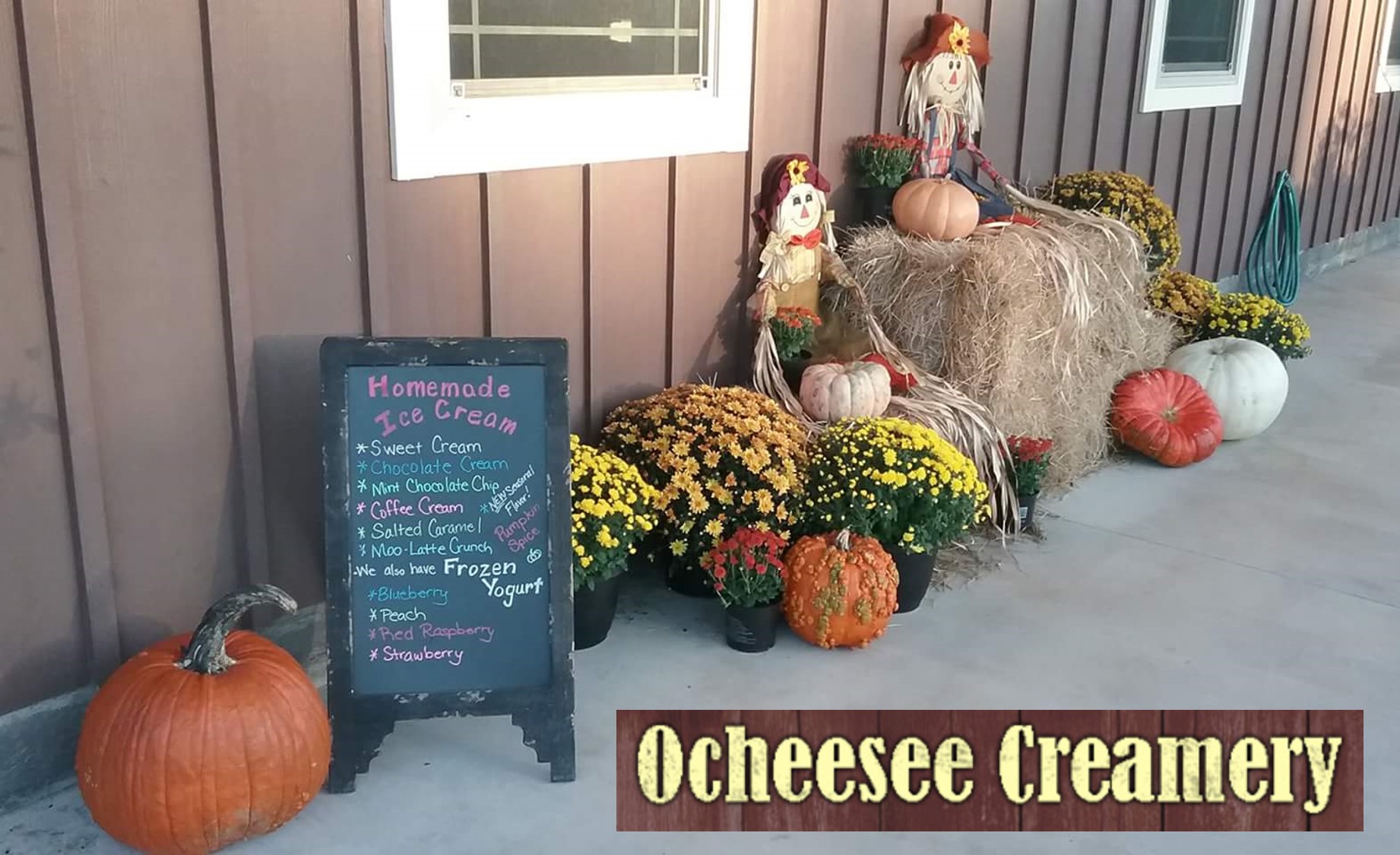
by Judy Biss | Nov 20, 2017

The Ocheesee Creamery in Calhoun County Florida participates in the annual regional Farm Tour highlighting a number of agritourism opportunities in North Florida. Photo Credit: Ocheesee Creamery
It seems each weekend this time of year is packed with things to do outside; and for good reason! The weather is perfect and the holidays are approaching. Among the many festivals and festivities are a number of farm tours, or “agritourism” related events. For example, there was the recent Tallahassee and surrounding area “10th Annual Farm Tour: “Farms, Gardens and Ranches,” and Jackson County just hosted the annual “Antique Tractor Drive” as part of its Farm City Festival.
The Merriam Webster definition of “Agritourism” is “the practice of touring agricultural areas to see farms and often to participate in farm activities.” More specifically, pursuant to Florida Statute 570.961 the definition of agritourism in Florida is “any agricultural related activity consistent with a bona fide farm or ranch or in a working forest which allows members of the general public to view or enjoy activities related to farming, ranching, historical, cultural or harvest-your-own attractions for recreational, entertainment or educational purposes.”
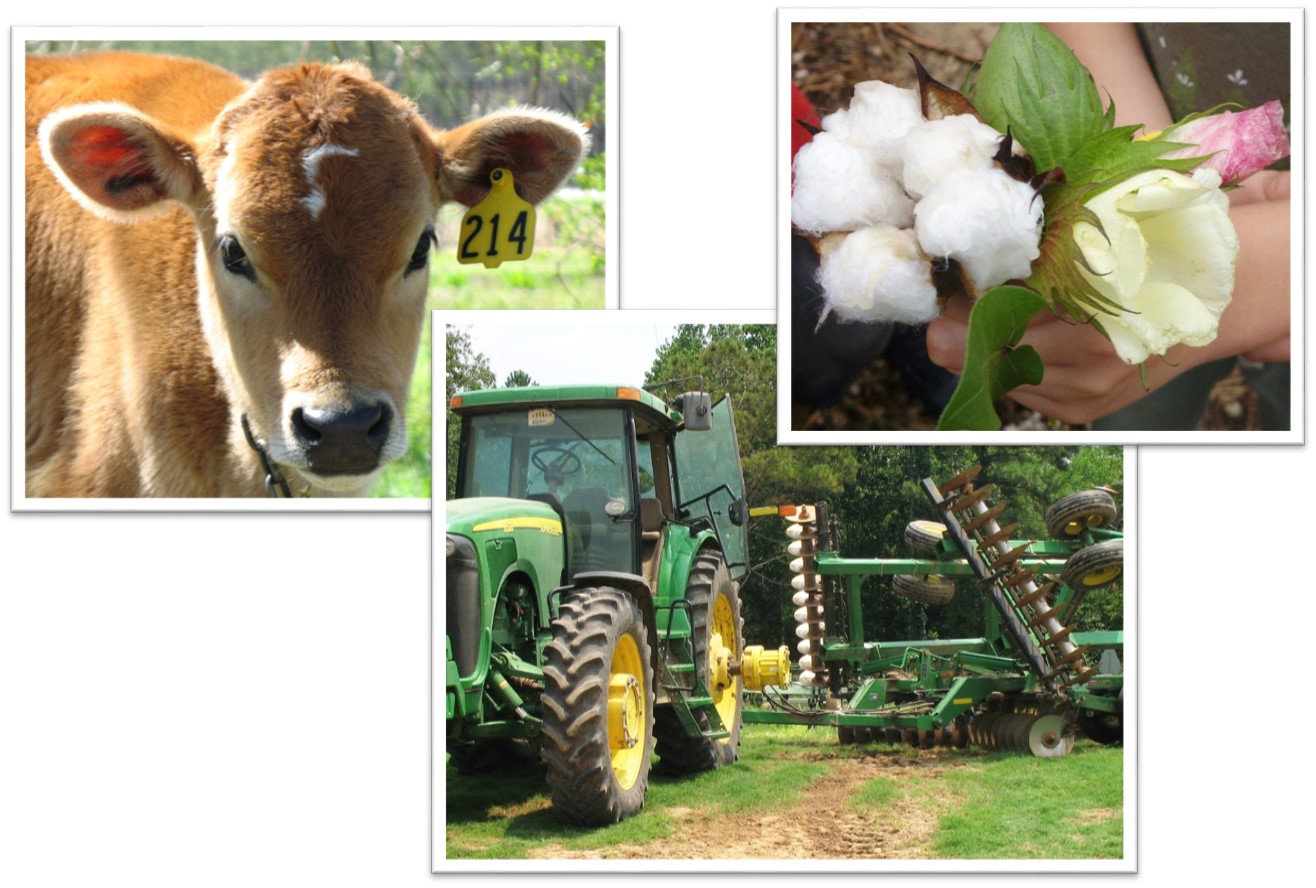
North Florida is home to a rich agricultural industry. Photo Credit Judy Biss
Panhandle Florida is an agriculturally diverse region growing everything from row crops like cotton, corn, soybeans, and peanuts to hay, timber, beef cattle, dairy cattle, fruit, vegetables, and even shellfish along the coast. Many farms are beginning to offer agritourism related opportunities as a means to increase income, but also to increase awareness of the importance of agriculture, in its many diverse ways, to our lives.
Many farms and ranches also have large tracts of land that are left uncultivated and serve as natural areas for surrounding fish and wildlife. Because of this, many farms are not only prime candidates for agritourism, but “ecotourism” as well. In addition to our numerous national forests and state parks many private landowners also have the potential to market their natural areas through ecotourism. This, also, is a relatively new industry in Florida, and more can be read about it here: Ecotourism
“Growing agritourism in Florida is a terrific way of marrying two of our oldest industries: tourism and agriculture,” said Commissioner of Agriculture Adam H. Putnam. “The growth and success of agritourism in Florida is not only good for our economy, it also celebrates the people, families and businesses that make up Florida agriculture.” (Jul 27, 2016, Commissioner Adam Putnam and VISIT FLORIDA Promote Florida Agritourism, Press release)
For more information on this topic, please see the following UF/IFAS Publications and related websites.
by Laura Tiu | Nov 20, 2017
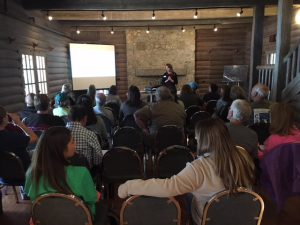
The lodge at Camp Helen State Park was the perfect backdrop for the Coastal Dune Lake Seminar Series Water School. Brandy Foley of the Choctawhatchee Basin Alliance shares her paleolimnology research work on the lakes.
On a beautiful October day, 35 people gathered at the Camp Helen State Park lodge to share information about the rare Coastal Dune Lakes (CDLs) that line the coast of Walton and Bay Counties. Organized by the University of Florida Extension Programs in Bay and Walton counties, the Water School included a morning seminar series featuring speakers from various groups that work together to support the lakes. Laura Tiu, Sea Grant Agent for Walton and Okaloosa counties started off the day giving a broad overview of the history and ecology of the lakes. Brandy Foley of the Choctawhatchee Basin Alliance shared her research on the paleolimnology, or study of the lake sediments over time, of two coastal dune lakes. Clayton Iron Wolf, a ranger at Camp Helen, gave a summary of the importance of Lake Powell and its benefit to the park. Jeff Talbert of the Atlanta Botanical Garden thrilled attendees with his pictures and research on the Deer Lake State Park restoration project. Norm Capra, who wears many hats, including that of the Lake Powell Community Alliance and Friends of Camp Helen State Park, shared the work they have done promoting conservation of shorebirds there. Dr. Dana Stephens, Director of the Mattie Kelly Environmental Institute at Northwest Florida State College shared analyses of many years of water chemistry and quality data collected on the lakes. Melinda Gates, Environmental Specialist for Walton County, wrapped up with a presentation on the efforts to protect and preserve the lakes.
The attendees seemed pleased with the event with one hundred percent of attendees rating the quality of information presented, usefulness of information, speakers’ knowledge, overall value of the program, and quality of location as good or excellent. The seminar helped attendees identify important roles of the CDLs in the ecosystem and understand why it is important to protect them. Several participants plan to make behavior changes based in the workshop including: joining or volunteering with Choctawhatchee Basin Alliance, Audubon, Sierra Club or Lake Watch Volunteers; sharing the information; living minimally; and engaging in activism. The seminar was followed by a kayak tour lead by Scott Jackson, Bay County Sea Grant Agent, to the outflow of Lake Powell and a visit to a faux sea turtle nest demonstration by Florida Fish and Wildlife Commission. This Water School was part of a regional series offered by UF/IFAS Extension. For more information on future schools, please subscribe to our Panhandle Outdoors Newsletter.
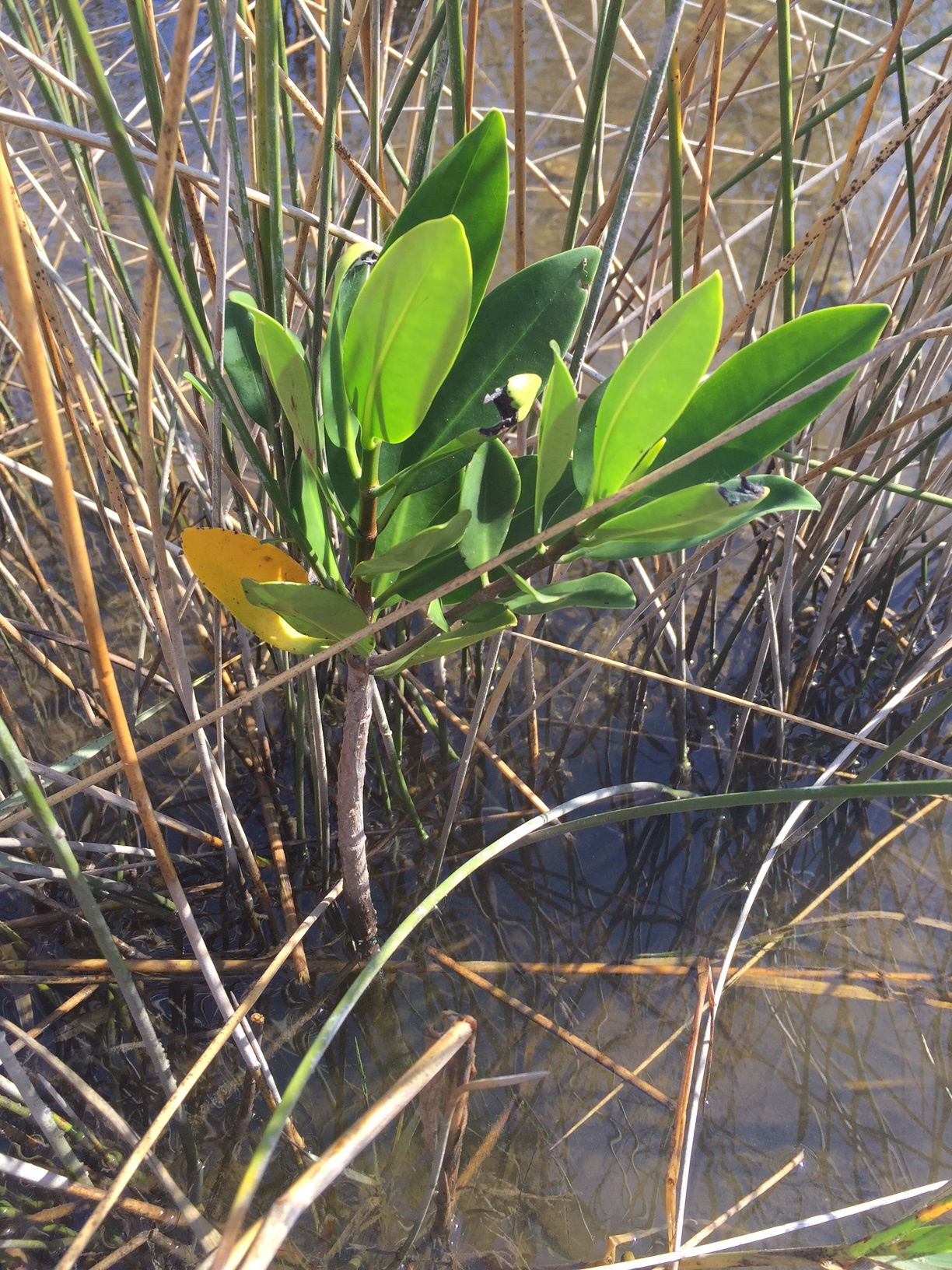
by Carrie Stevenson | Nov 3, 2017
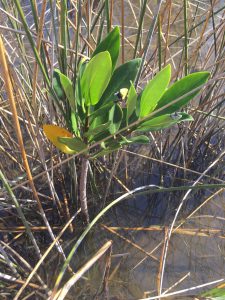
Red mangrove growing among black needlerush in Perdido Key. Photo credit: Carrie Stevenson, UF IFAS Extension
Discovering something new is possibly the most exciting thing a field biologist can do. As students, budding biologists imagine coming across something no one else has ever noticed before, maybe even getting the opportunity to name a new bird, fish, or plant after themselves.
Well, here in Pensacola, we are discovering something that, while already named and common in other places, is extraordinarily rare for us. What we have found are red mangroves. Mangroves are small to medium-sized trees that grow in brackish coastal marshes. There are three common kinds of mangroves, black (Avicennia germinans), white (Laguncularia racemosa), and red (Rhizophora mangle).
Black mangroves are typically the northernmost dwelling species, as they can tolerate occasional freezes. They have maintained a large population in south Louisiana’s Chandeleur Islands for many years. White and red mangroves, however, typically thrive in climates that are warmer year-round—think of a latitude near Cedar Key and south. The unique prop roots of a red mangrove (often called a “walking tree”) jut out of the water, forming a thick mat of difficult-to-walk-through habitat for coastal fish, birds, and mammals. In tropical and semi-tropical locations, they form a highly productive ecosystem for estuarine fish and invertebrates, including sea urchins, oysters, mangrove and mud crabs, snapper, snook, and shrimp.
Interestingly, botanists and ecologists have been observing an expansion in range for all mangroves in the past few years. A study published 3 years ago (Cavanaugh, 2014) documented mangroves moving north along a stretch of coastline near St. Augustine. There, the mangrove population doubled between 1984-2011. The working theory behind this expansion (observed worldwide) is not necessarily warming average temperatures, but fewer hard freezes in the winter. The handful of red mangroves we have identified in the Perdido Key area have been living among the needlerush and cordgrass-dominated salt marsh quite happily for at least a full year.
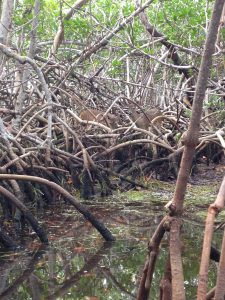
Key deer thrive in mangrove forests in south Florida. Photo credit: Carrie Stevenson, UF IFAS Extension
Two researchers from Dauphin Island Sea Lab are planning to expand a study published in 2014 to determine the extent of mangrove expansion in the northern Gulf Coast. After observing black mangroves growing on barrier islands in Mississippi and Alabama, we are working with them to start a citizen science initiative that may help locate more mangroves in the Florida panhandle.
So what does all of this mean? Are mangroves taking over our salt marshes? Where did they come from? Are they going to outcompete our salt marshes by shading them out, as they have elsewhere? Will this change the food web within the marshes? Will we start getting roseate spoonbills and frigate birds nesting in north Florida? Is this a fluke due to a single warm winter, and they will die off when we get a freeze below 25° F in January? These are the questions we, and our fellow ecologists, will be asking and researching. What we do know is that red mangrove propagules (seed pods) have been floating up to north Florida for many years, but never had the right conditions to take root and thrive. Mangroves are native, beneficial plants that stabilize and protect coastlines from storms and erosion and provide valuable food and habitat for wildlife. Only time will tell if they will become commonplace in our area.
If you are curious about mangroves or interested in volunteering as an observer for the upcoming study, please contact me at ctsteven@ufl.edu. We enjoy hearing from our readers.
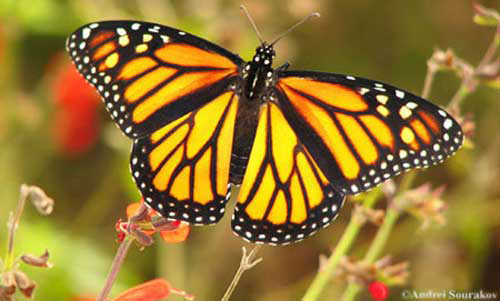
by Sheila Dunning | Nov 3, 2017
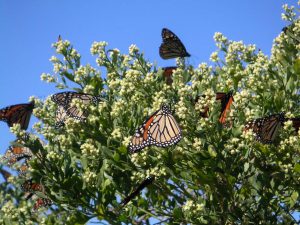 Since we are approaching the peak dates in mid-October, it is time to get your gardens ready for migrating monarchs to fuel up on nectar sources. In their Mexican overwintering sites, these monarchs will have to survive on stored fat all winter. So they need to build up fat reserves by feeding on flowering plants along their migration route. Saltbush, Goldenrod, Narrowleaf Sunflower, Blanketflower and Milkweed are some of the nectar-rich blooms in the Florida Panhandle this time of year.
Since we are approaching the peak dates in mid-October, it is time to get your gardens ready for migrating monarchs to fuel up on nectar sources. In their Mexican overwintering sites, these monarchs will have to survive on stored fat all winter. So they need to build up fat reserves by feeding on flowering plants along their migration route. Saltbush, Goldenrod, Narrowleaf Sunflower, Blanketflower and Milkweed are some of the nectar-rich blooms in the Florida Panhandle this time of year.
Monarchs begin leaving the northern US and Canada in mid-August. They usually fly for 4-6 hours during the day, coming down from the skies to feed in the afternoon and then find roosting sites for the night. Warmth and nectar enable butterflies to gain the energy needed to keep on flying. Monarchs cannot fly unless their flight muscles reach 55ºF. On a sunny day, they bask by extending their wings to allow the black scales on their bodies to absorb heat. But on a cloudy day, they generally don’t fly if it is below 60ºF.
These graceful insects capitalize on the warm air they encounter when they head south. Thermals are columns of rising air, caused by uneven heating of the earth. They form wherever the air is just a few degrees warmer than the air next to it. Thermals often form wherever large patches of dark ground are adjacent to lighter-colored ground, such as over parking lots, above farm fields, highways, and next to rivers and lakes. Monarchs are so light that they can easily be lifted by the rising air.
But they are not weightless. In order to stay in the air, they must move forward while also staying within the thermal. They do this by moving in a circle. At that point, the monarch glides forward in a south/southwesterly direction with the aid of the wind. It glides until it finds another thermal, and rides that column of rising air upwards again. Monarchs can glide forward 3-4 feet for every foot they drop in altitude. If they have favorable tail winds, monarchs can flap their wings once every 20-30 feet and still maintain altitude.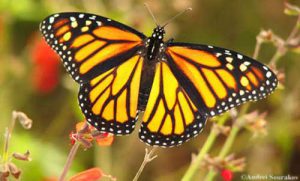
When winds are from the south, monarchs fly very low, often choosing to land and find cover or refuel on available nectar sources. They may wait for the winds to change direction, and as a result, can form large roosts as they accumulate in a protected location.
The average pace of the migration is around 20-30 miles per day. But tag recoveries have shown that monarchs can fly 150 miles or more in a single day if conditions are favorable. Monarchs migrate during the day, coming down at night to gather together in clusters in a protected area. In the south, they might choose oak or pecan trees, especially if the trees are overhanging a stream channel.
Monarchs migrate alone—they do not travel in flocks like birds do. So they often descend from the sky in the afternoon to feed, and then search for an appropriate roosting site. Most roosts last only 1 or 2 nights, but some may last a few weeks.
How do monarchs find their way to Mexico? We really don’t know for certain. We do know that monarchs have a sun compass in their brain, and a circadian clock in their antennae. The clock and compass are integrated in the brain to form a time-compensated sun compass. Using the sun and polarized light waves, monarchs can maintain a general S/SW heading throughout the day. Even with that, it is amazing that they can find the exact spot year after year.










